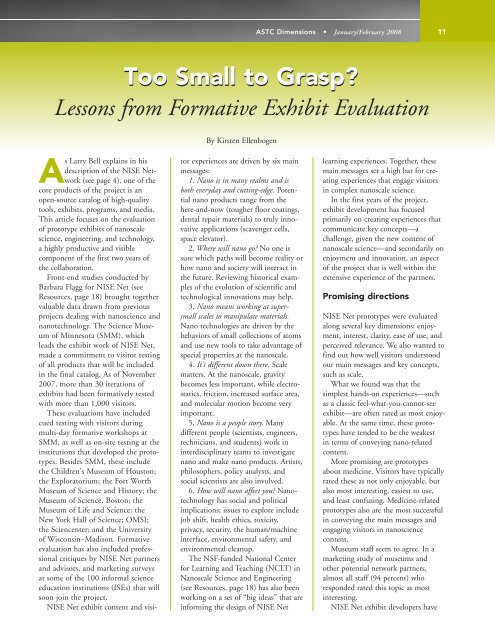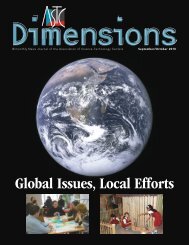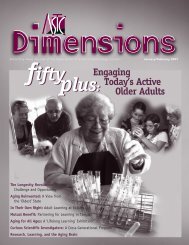Scientists Speak about Nano - Association of Science - Technology ...
Scientists Speak about Nano - Association of Science - Technology ...
Scientists Speak about Nano - Association of Science - Technology ...
Create successful ePaper yourself
Turn your PDF publications into a flip-book with our unique Google optimized e-Paper software.
By Kirsten Ellenbogen<br />
ASTC Dimensions • January/February 2008 11<br />
Too Small to Grasp?<br />
Lessons from Formative Exhibit Evaluation<br />
As Larry Bell explains in his<br />
description <strong>of</strong> the NISE Network<br />
(see page 4), one <strong>of</strong> the<br />
core products <strong>of</strong> the project is an<br />
open-source catalog <strong>of</strong> high-quality<br />
tools, exhibits, programs, and media.<br />
This article focuses on the evaluation<br />
<strong>of</strong> prototype exhibits <strong>of</strong> nanoscale<br />
science, engineering, and technology,<br />
a highly productive and visible<br />
component <strong>of</strong> the first two years <strong>of</strong><br />
the collaboration.<br />
Front-end studies conducted by<br />
Barbara Flagg for NISE Net (see<br />
Resources, page 18) brought together<br />
valuable data drawn from previous<br />
projects dealing with nanoscience and<br />
nanotechnology. The <strong>Science</strong> Museum<br />
<strong>of</strong> Minnesota (SMM), which<br />
leads the exhibit work <strong>of</strong> NISE Net,<br />
made a commitment to visitor testing<br />
<strong>of</strong> all products that will be included<br />
in the final catalog. As <strong>of</strong> November<br />
2007, more than 30 iterations <strong>of</strong><br />
exhibits had been formatively tested<br />
with more than 1,000 visitors.<br />
These evaluations have included<br />
cued testing with visitors during<br />
multi-day formative workshops at<br />
SMM, as well as on-site testing at the<br />
institutions that developed the prototypes.<br />
Besides SMM, these include<br />
the Children’s Museum <strong>of</strong> Houston;<br />
the Exploratorium; the Fort Worth<br />
Museum <strong>of</strong> <strong>Science</strong> and History; the<br />
Museum <strong>of</strong> <strong>Science</strong>, Boston; the<br />
Museum <strong>of</strong> Life and <strong>Science</strong>; the<br />
New York Hall <strong>of</strong> <strong>Science</strong>; OMSI;<br />
the <strong>Science</strong>nter; and the University<br />
<strong>of</strong> Wisconsin–Madison. Formative<br />
evaluation has also included pr<strong>of</strong>essional<br />
critiques by NISE Net partners<br />
and advisors, and marketing surveys<br />
at some <strong>of</strong> the 100 informal science<br />
education institutions (ISEs) that will<br />
soon join the project.<br />
NISE Net exhibit content and visi-<br />
tor experiences are driven by six main<br />
messages:<br />
1. <strong>Nano</strong> is in many realms and is<br />
both everyday and cutting-edge. Potential<br />
nano products range from the<br />
here-and-now (tougher floor coatings,<br />
dental repair materials) to truly innovative<br />
applications (scavenger cells,<br />
space elevator).<br />
2. Where will nano go? No one is<br />
sure which paths will become reality or<br />
how nano and society will interact in<br />
the future. Reviewing historical examples<br />
<strong>of</strong> the evolution <strong>of</strong> scientific and<br />
technological innovations may help.<br />
3. <strong>Nano</strong> means working at supersmall<br />
scales to manipulate materials.<br />
<strong>Nano</strong> technologies are driven by the<br />
behaviors <strong>of</strong> small collections <strong>of</strong> atoms<br />
and use new tools to take advantage <strong>of</strong><br />
special properties at the nanoscale.<br />
4. It’s different down there. Scale<br />
matters. At the nanoscale, gravity<br />
becomes less important, while electrostatics,<br />
friction, increased surface area,<br />
and molecular motion become very<br />
important.<br />
5. <strong>Nano</strong> is a people story. Many<br />
different people (scientists, engineers,<br />
technicians, and students) work in<br />
interdisciplinary teams to investigate<br />
nano and make nano products. Artists,<br />
philosophers, policy analysts, and<br />
social scientists are also involved.<br />
6. How will nano affect you? <strong>Nano</strong>technology<br />
has social and political<br />
implications; issues to explore include<br />
job shift, health ethics, toxicity,<br />
privacy, security, the human/machine<br />
interface, environmental safety, and<br />
environmental cleanup.<br />
The NSF-funded National Center<br />
for Learning and Teaching (NCLT) in<br />
<strong>Nano</strong>scale <strong>Science</strong> and Engineering<br />
(see Resources, page 18) has also been<br />
working on a set <strong>of</strong> “big ideas” that are<br />
informing the design <strong>of</strong> NISE Net<br />
learning experiences. Together, these<br />
main messages set a high bar for creating<br />
experiences that engage visitors<br />
in complex nanoscale science.<br />
In the first years <strong>of</strong> the project,<br />
exhibit development has focused<br />
primarily on creating experiences that<br />
communicate key concepts—a<br />
challenge, given the new content <strong>of</strong><br />
nanoscale science—and secondarily on<br />
enjoyment and innovation, an aspect<br />
<strong>of</strong> the project that is well within the<br />
extensive experience <strong>of</strong> the partners.<br />
Promising directions<br />
NISE Net prototypes were evaluated<br />
along several key dimensions: enjoyment,<br />
interest, clarity, ease <strong>of</strong> use, and<br />
perceived relevance. We also wanted to<br />
find out how well visitors understood<br />
our main messages and key concepts,<br />
such as scale.<br />
What we found was that the<br />
simplest hands-on experiences—such<br />
as a classic feel-what-you-cannot-see<br />
exhibit—are <strong>of</strong>ten rated as most enjoyable.<br />
At the same time, these prototypes<br />
have tended to be the weakest<br />
in terms <strong>of</strong> conveying nano-related<br />
content.<br />
More promising are prototypes<br />
<strong>about</strong> medicine. Visitors have typically<br />
rated these as not only enjoyable, but<br />
also most interesting, easiest to use,<br />
and least confusing. Medicine-related<br />
prototypes also are the most successful<br />
in conveying the main messages and<br />
engaging visitors in nanoscience<br />
content.<br />
Museum staff seem to agree. In a<br />
marketing study <strong>of</strong> museums and<br />
other potential network partners,<br />
almost all staff (94 percent) who<br />
responded rated this topic as most<br />
interesting.<br />
NISE Net exhibit developers have





